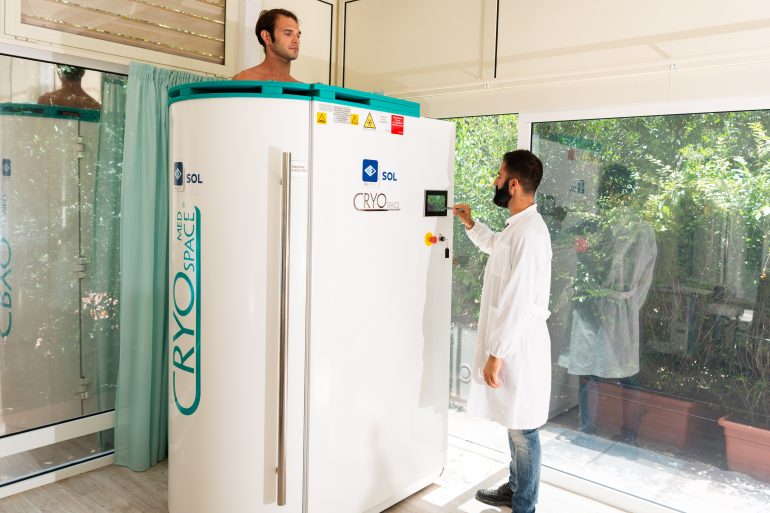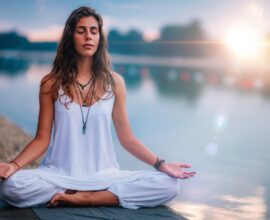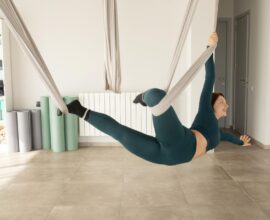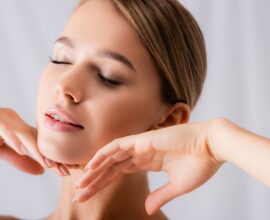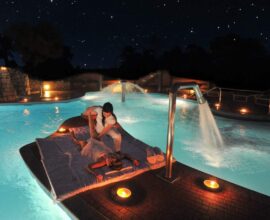What is Cryosauna, what is the purpose and what are the benefits
Cryosauna: all you need to know about the therapy with cold
Taking care of your health includes: sleeping well, eating balanced meals, regular physical activity, even if moderate, and allowing yourself wellness treatments like a relaxing massage with Ayurvedic oils or a session in the cryosauna.
The Cryosauna is also known as the cryocabin or cryo-chamber, it’s a device to perform systematic cryotherapy treatments which involve exposing the body to temperatures between -120 and -180° C for no longer than 3 minutes.
The term cryotherapy comes from the Greek word Kyros which means cure with cold. This non-invasive and painless treatment uses the therapeutic properties of cold for aesthetic and curative results. An innovative technique with many benefits for the organism, mainly used in aesthetic and rehabilitation medicine.
How does the therapy session with cold work? Before entering the vertical cabin, where the starting temperature is more or less 0 degrees, one must adapt to the environment’s temperature for 10 to 20 minutes. After putting on gloves, stockings, wooden soul shoes and underwear in natural fabric (except for underwired bras), it’s time to enter the Cryochamber which has a door that closes magnetically.
It’s important to remember not to wear metal objects inside the Cryosauna to avoid being burned by the cold. Also, the skin must be completely dry, free of sweat or creams.
The shoulder height cabin is closed and thermally isolated. Once the client is inside the chamber, their body is surrounded by a cloud of liquid nitrogen in gas form. The temperature drops to -150 in just 40 seconds, differently from a traditional sauna, the cryosauna is completely dry and has no humidity.
Although there is always an operator present during the entire process who will open the magnetic door once the session is over, the door can be opened at any time by the client if they want to exit the cabin.
At the end of the treatment, there are 15 minutes of soft gymnastics to help reactivate the blood circulation.
Let’s now discover what happens to the organism when put under such low temperatures and the benefits of the cryosauna.

Cryosauna: what happens to the body and how does the organism benefit from being in the cold
While doing a cryosauna session, the body is exposed to temperatures between -110°C and -160°C for a few seconds, causing a thermal shock which triggers a series of benefits for the organism.
The thermoreceptors in the skin are activated and trigger the brain to sends a series of signals to the organism to contrast the cold. The first reaction is the massive-vasoconstriction during which the blood full of oxygen and enzymes, is sent to the central zones of the body to protect the vital organs. At this moment inhibitors such as serotonin and ACTH hormone are released.
The vasoconstriction is followed by a strong reaction of vasodilatation (up to four times stronger than a normal bool flux), improving blood circulation and generating a “pump effect”, which stimulates circulation and relieves the body from inflammation.
The cryosauna is typically used for sports-men in case of:
- Muscular lesions and painful syndromes caused by fatigue
- Prevent severe tendinopathies or overload
- Stimulate post-exercise recovery
- Fight fatigue
- Contrast the inflation of tissues
- Relax the muscles and improve articular mobility
- Improve the athlete’s performance, the quality of their sleep and humour
Cold therapy is also used in beauty: it fights the non-aesthetic effects of cellulitis, improves the luminosity and elasticity of the skin, and slows down the ageing process by slowing down the formation of wrinkles, its also effective against acne psoriasis, dermatitis, eczema, oedema and herpes. Also, after being inside a cryogenic environment, the metabolism appears to be accelerated up to 7 times as much.
Systematic cryotherapy has an analgesic effect and stimulates the production of painkiller and anti-inflammatory substances such as endorphins and cytokine.

It’s recommended for:
- Joint pain and rigidity post-operation
- Lumbago and neck pain
- Inflammatory pathologies of the locomotive apparatus
- Pain caused by an overload of the joints trauma, tendons and muscles
- paper-laginous lesions and capsulo-ligamentosa
- psoriatic arthritis
- myositis and fibromyositis
- chronic polyarthritis;
- prevention of primary and secondary osteoporosis
- fibromyalgic syndrome
- states of anxiety and depression
The number of cryotherapy sessions varies according to the needs and objectives you want to achieve.
It’s important to remember that cold therapy is not advised in case the clients have had or are:
- stroke
- epilepsy
- malignant tumours
- pregnant women
- pacemaker carriers
- heart disease at serious risk
- hypertension diseases
- severe claustrophobic syndromes
- severe cerebral vascular diseases
Would you like to experience the benefits of the cryosauna and live a dream holiday in a real paradise? Discover the Forte Village Resort in Sardinia.
